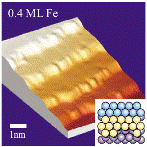Department of Physics and Astronomy: Publications and Other Research

Axel Enders Publications
Document Type
Article
Date of this Version
2010
Citation
Journal of Physical Chemistry C 114:20 (2010), pp 9408–9415; doi: 10.1021/jp1012957
Abstract
The structure−electronic structure relationship of nonmetalated meso-tetraphenyl porphyrin (2H-TPP) on the (111) surfaces of Ag, Cu, and Au was studied with a combination of scanning tunneling microscopy, photoelectron spectroscopy, and density functional theory. We observe that the molecules form a 2D network on Ag(111), driven by attractive intermolecular interactions, while the surface migration barriers are comparatively small and the charge transfer to the adsorbed molecules is minimal. This is in contrast to a significant charge transfer observed in 2H-TPP/Cu(111), resulting in repulsive forces between the molecules that prevent molecular adlayer network formation. It is shown that the limiting factor in formation of self-organized networks is the nature of the frontier orbital overlap and the adsorbate−interface electron transfer. Further, the electronic structure, most notably the HOMO−LUMO splitting, are found to be dependent on the substrate as well. The comparison of the results in this article with published work on similar porphyrins suggests that the molecule−substrate interaction strength is determined by the molecule’s metalation, and not so much by the ligands.


Comments
Copyright © 2010 American Chemical Society. Used by permission.